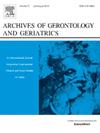The temporal trend in frailty prevalence from 2011 to 2020 and disparities by equity factors among middle-aged and older people in China: A population-based study
IF 3.8
3区 医学
Q2 GERIATRICS & GERONTOLOGY
引用次数: 0
Abstract
Background
Frailty is a challenging issue in China, however the prevalence of frailty across different population groups and whether this is changing over time remain unclear.
Methods
Unstandardized and age-and sex-standardized prevalence of frailty (95 % confidence interval (95 % CI)) (Frailty Index) in the overall sample and for subgroups defined by equity factors (PROGRESS-Plus framework) from 2011 to 2020 were estimated using analyses of cross-sectional surveys in adults aged 45 and older participating in 5 waves (N = 16,784 to 18,904 across waves) of the China Health and Retirement Longitudinal Studies (CHARLS). Poisson regression was used to estimate prevalence ratios (PRs) of frailty by equity factors.
Results
Unstandardized prevalence of frailty increased from 13.6 % (13.0 %-14.1 %) in 2011 to 18.7 % (18.1 %-19.3 %) in 2020.The standardized prevalence increased from 13.5 % (13.0 %-14.0 %) in 2011 to 16.3 % (15.8 %-16.9 %) in 2020. Frailty was consistently more prevalent at advanced ages, in rural areas, among females, as well as those less educated, without social engagement, and non-drinkers. Based on the Poisson regression model, non-north region, being female and older, lower education, having no social engagement, smoking and non-drinking, and higher household capital consumption were associated with higher prevalence.
Conclusions
The prevalence of frailty among the middle-aged and older population in China has increased. There will be an associated health and social care cost. Interventions targeted at older adults, those in rural areas, women, as well as those less educated, having no social engagement, and non-drinkers to mitigate the negative effects of frailty may be warranted.
2011 - 2020年中国中老年人群虚弱患病率的时间趋势及公平性因素差异:一项基于人群的研究
在中国,虚弱是一个具有挑战性的问题,然而,不同人群中虚弱的患病率以及这种情况是否会随着时间的推移而发生变化仍不清楚。方法利用中国健康与退休纵向研究(CHARLS)的5个波(N = 16,784至18,904个波)中45岁及以上成年人的横断面调查分析,估计2011年至2020年整个样本和公平因素(PROGRESS-Plus框架)定义的亚组中未标准化、年龄和性别标准化的虚弱患病率(95%置信区间(95% CI))(虚弱指数)。用泊松回归估计公平性因子的脆弱性患病率(pr)。结果脆弱标准化患病率由2011年的13.6%(13.0% ~ 14.1%)上升至2020年的18.7%(18.1% ~ 19.3%)。标准化患病率由2011年的13.5%(13.0% ~ 14.0%)上升至2020年的16.3%(15.8% ~ 16.9%)。在老年、农村地区、女性以及受教育程度较低、没有社交活动和不喝酒的人群中,身体虚弱的情况更为普遍。基于泊松回归模型,非北方地区、女性年龄较大、受教育程度较低、无社会参与、吸烟不饮酒、家庭资本消耗较高与患病率较高相关。结论中国中老年人群的虚弱患病率呈上升趋势。这将产生相关的卫生和社会保健费用。针对老年人、农村地区的人、妇女、受教育程度较低的人、没有社交活动的人以及不喝酒的人进行干预,以减轻虚弱的负面影响,可能是有必要的。
本文章由计算机程序翻译,如有差异,请以英文原文为准。
求助全文
约1分钟内获得全文
求助全文
来源期刊
CiteScore
7.30
自引率
5.00%
发文量
198
审稿时长
16 days
期刊介绍:
Archives of Gerontology and Geriatrics provides a medium for the publication of papers from the fields of experimental gerontology and clinical and social geriatrics. The principal aim of the journal is to facilitate the exchange of information between specialists in these three fields of gerontological research. Experimental papers dealing with the basic mechanisms of aging at molecular, cellular, tissue or organ levels will be published.
Clinical papers will be accepted if they provide sufficiently new information or are of fundamental importance for the knowledge of human aging. Purely descriptive clinical papers will be accepted only if the results permit further interpretation. Papers dealing with anti-aging pharmacological preparations in humans are welcome. Papers on the social aspects of geriatrics will be accepted if they are of general interest regarding the epidemiology of aging and the efficiency and working methods of the social organizations for the health care of the elderly.

 求助内容:
求助内容: 应助结果提醒方式:
应助结果提醒方式:


